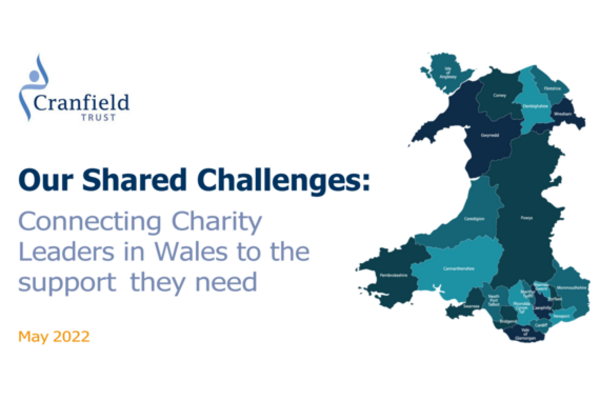Getting to grips with the ‘new normal’
Another expression has crept into the lexicon surrounding Covid 19 in the last few weeks, namely the "new normal". For all in the charity sector, getting to grips with what this might mean for our organisations is something I suggest, that needs to be addressed now. Not later, not afterwards but, right now. Across the charity sector, focus has, quite rightly, been on survival and for many in the sector, this focus on survival is going to continue for some time to come. That said, nobody in the charity sector can ignore the fact that the world is unlikely to return to pre-Covid conditions, at least for a very long time. So, navigating the future successfully by recrafting your strategy will be an essential start point for any charity’s senior team. In the next few paragraphs, I hope to share some simple yet effective ways you can kick start your way out of crisis and into recovery.
Take a long view
Let me do the 'gloom and doom' bit first and get this over with. We will not linger on it! The UK economy is predicted to shrink by up to 30%. Globally the figure could be significantly worse. The colossal sums of money that have been pumped into the UK economy will need to be repaid from somewhere and that is likely to be in the form of increased taxation and cuts in public expenditure, possibly over a prolonged period of time. The response from the state to the charity sector's plight in the current pandemic has also been muddied and for many, slow. This is ironic as, demand for services from many in the sector has at this time increased significantly. The state's wavering between centralisation of services and just leaving other things “to the market to sort out” does not sit easily with the notion of a thriving charity sector. All that said, it is not all 'gloom and doom'. Indeed, for charities that are prepared to take a long view, revise their strategy, and get moving quickly, there could well be a raft of opportunities presented by the 'new normal'.

Practical Strategic Planning Exercise for you Charity
To help focus your thinking on how to get to grips with the 'new normal', I am offering a simple, quick, and effective strategic planning exercise that you can run with your staff and trustees. To keep it simple, just think of your strategy as 'guiding principles' and directions where you will be heading over the next 12-18 months. You can also run this exercise remotely. It will help to shape your conversations.
Forget ‘Command and Control’ - be responsive and review regularly
Broadly speaking, the traditional idea of a ‘command and control’ type strategy where, grand ideas are set in tablets of stone and trickled throughout the rest of the organisation, is dead in the water. The world is no longer such a certain place – it is too brittle! If your current strategy falls into this category, then, I offer that you are in trouble ( or at very least, condemning yourself to spending ages rewriting a document that will be defunct by the time the ink is dry on it). Instead, my suggestion is that you need to develop a more responsive style of strategy and, (please pay attention to this bit), a formal and regular means of reviewing and validating it.
Annual reviews of strategy are too disconnected from the pace of events unfolding. So, unless your charity has the footwork of Fred Astaire, you have scant chance of being able to make the organisational changes or shifts in focus required not just to keep up, with, but get ahead of events. None of this is particularly onerous but it requires simple steps, regularity, and perseverance to make it happen. So, let us move towards how we craft a more responsive strategy.
Create a responsive strategy
Before we start let us demystify strategy. A strategy It is a broad set of high-level goals you want to achieve for the beneficiaries of your charity…. simple as that. Nothing arcane about it. The only thing I would suggest, is to pitch your strategic goals at a high level…do not load them with all sorts of prescriptive operational details and hidebound them with dates and times strapped down to the minute of the day. By way of example, here is what I consider a strategic goal, “To be the preferred supplier to the local community for service X by the end of 2021”. Contrast this with what I consider to be an operational goal, “To have contacted 25 local authorities and delivered presentations to their senior management teams by March 31st, 2022”. I trust you spot the difference.
Six steps to a successful responsive strategy

As to how we arrive at a more responsive strategy, let us demystify that process too. Here are the steps to undertake – and you can do them quickly.
- Speculate - Get a view of the world, as may affect your charity, with a range of insights and perspectives
- Validate - this view of the world
- Direction - Set a clear direction (your strategic goals)
- Act – operational actions
- Review - evaluate the effectiveness of your actions regularly
- Repeat - Go back to step 1
Step 1 – Speculate
This part of the exercise is where you ask your team to speculate on what the ‘new normal’ may look like. Pose the question, “What might the world look like in 6 months’ time and 12 months’ time”? Provide simple cues to help the team marshal their thoughts so, helpful prompts may be to ask them to consider the following areas:
- Social changes – What might change in society in terms of how people behave that would affect us? An obvious example being social distancing and its legacy if your charity depends on footfall. Less obvious examples may be different types of behaviour becoming more prominent or unintended social issues – for example, the correlation between domestic abuse and lockdown conditions or, the effects on already marginalised members of society. The key is to look at behavioural changes in your donor base and, the beneficiaries of your charity Existential changes – What changes may happen that could close you down quickly? There is no point in avoiding or denying this question. Over-dependence on a single donor or source of funding that ends up going to the wall is an obvious candidate but, regime change in a foreign country or, the development of a new treatment or technological innovation may well render your mission defunct. The answers to this question are likely to be embedded in the above questions but, it is always worth asking it explicitly!
- Economic changes – What economic changes are likely to happen that will affect us? Clearly a major concern is where money/funding may come from but equally, the demand for your services may well explode exponentially. For some in the sector there may be opportunities created by new funding streams.
- Operational changes – What might happen to ‘ways of work’ that will affect your charity? Again, social distancing and its legacy may well affect profoundly the way that you can work or interact with beneficiaries or your donor base.
- Political/legal changes – What might change in terms of the law that might affect you? So, for example, the government may introduce legislation or, policy changes which may give a greater role to your charity in the day to day delivery of services or, conversely it may seek to centralise delivery (and marginalise the charity sector!).
- Environmental/technological changes - What changes in the environment may affect us? Again, the legacy of social distancing and its effect on travel is a more obvious change that may happen but, what of changes in say, modes of transport or, working hours and how may that affect your charity? For charities involved in overseas work, impacts on travel may well have complex and troublesome impacts on how they can deliver work in their chosen areas.
Once you have collected all your team’s submissions to this part of the exercise, group the answers together under each of the areas( so, social, political, environmental, existential changes) and recirculate to the same group and ask them to move to the next part.
Step 2 – Validate
the views and insights gained from your speculation session. This is not to be critical or discount views and insights but rather to examine the risk or opportunity of each of them to your charity. To help you do this part simply pose the questions, “On a scale of 0-10, how big a risk is this to our charity” and, “On a scale of 0-10 how big an opportunity is this to our charity”. There will be opportunities so, I encourage you to help surface these too no matter how gloomy the outlook is!
Step 3 – Set the direction
For each of the areas, invite the team to look for any simple changes in the focus of what you do and how you do it, that would be an effective countermeasure or a useful harnessing of what that future change may be. So, for example, if your charity depends on social contact for delivery at present, is it possible to harness technology to reshape how you deliver services? There may be no obvious solutions to some of the problems thrown up and your team will need the judgement and focus to address these problems if they truly threaten your charity’s mission. The point of this process is to bring focus, discussion, and action to dealing with the ‘new normal’. Given where most of us are in the world now, my suggestion is to try and bring focus to things in your strategy that are ‘high payoff and low effort’ and ‘low payoff and low effort’. The stuff that would be in the ‘high payoff and high effort’ category is simply too risky now. You are simply looking for strategic directions that you enact quickly to navigate the future successfully. It is about getting beyond crisis management!
At the end of this part of the process, again, collect and tabulate all the responses and recirculate to the team. Now move onto the next part of the exercise.
Step 4 - Act
You are now going to decompose the strategy into operational steps. Normally, this is where your operational team need to step in. I am going to be controversial here and intentionally so. My suggestion is that your operations plan underpinning your strategy is restricted to 100 days. No annual or six-month plans. Simply 100 days. My reasoning is that any less than 100 days and, you are unlikely to see the full effect of your plan and more than 100 days and the plan takes on a life of its own and risks becoming disconnected from the pace of events in the rest of the world! The absolute key point here is simplicity – the operational plan MUST mirror in simple steps what the strategic goals you have agreed. To better help you understand this, think of your strategic goals as a ‘target’ and the operational plan as the ‘means’ of achieving it.
Step 5 – Review
Again, I suggest 100-day strategic reviews and be prepared to adjust your strategy accordingly. Be ruthless at this stage – if the data from your operational is telling you something then, be prepared to act on it. Do this review as a formal exercise with the board – dates, data, and decisions!
Step 6 – Go back to step 1
You will now have 100 days of data from your own actions to add into the mix as well.
I have tried to make the advice above as generic as possible. Across the charity sector, most organisations are at different stages and, getting to grips with the unique challenges that face them. So, feel free to adapt it however best suits you. That said, provided you are committed to following through on the steps I have set out, you are going to be in a much better shape than organisations that are floundering around and simply waiting for the next crisis or bad turn of events to steam into them.
The one great certainty is that the charity sector will survive, and that donors, beneficiaries and human compassion will not disappear. It may become tougher but then, let us be honest, it has never been easy in this sector! Lastly, if you are personally charged with leading your charity out of crisis and into the new normal, then remember, there is help there. You are not alone.
Stephen Cahill

Stephen Cahill is a semi-retired executive with extensive senior experience across the public, private and charity sectors. He specialises in helping organisations to achieve rapid results by focusing on,"the things that really matter". He has been active with The Cranfield Trust for nearly a decade.








